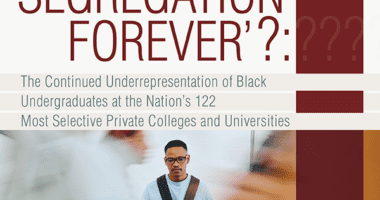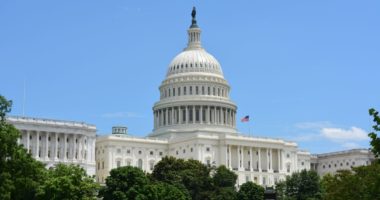Subprime Opportunity: high dividends, low baccalaureates at for-profit colleges
WASHINGTON (November 23, 2010) Three years after the U.S. housing market collapse, our country continues to suffer the effects of misplaced priorities and weak regulation of subprime mortgage lenders. Meanwhile, as a new report from The Education Trust warns, the most vulnerable Americans are being targeted by yet another set of corporations peddling access to the American dream but delivering little more than crippling debt. This time, its underregulated for-profit colleges.
Racking up eye-popping profits fueled by federal student aid subsidies and high-cost private student loans, these institutions have increased their enrollments by an astonishing 236 percent over the last 10 years. Their stockholders are literally making out like bandits, while their students many of whom are low-income and minority generally find little academic success.
Subprime Opportunity, the 10th Education Trust report in a series on college graduation rates, examines how high costs combined with low graduation rates at for-profit institutions dim the dreams of too many students who place their trust and their futures in the hands of these companies.
The report uses 2008 data on for-profits available from College Results Online, a unique Web-based tool that allows the public to view student success rates at four-year institutions across the country. These data show that while the six-year graduation rate among first-time, full-time freshmen seeking bachelors degrees at for-profit colleges is just 22 percent nationwide, success rates vary widely across those systems.
Here are a few examples:
-
- The University of Phoenix the nations largest for-profit postsecondary education provider collected more than $1 billion in federal Pell Grant aid last year. In 2008, however, its six-year graduation rate was just 9 percent. At individual Phoenix institutions, the highest student-success rate was 33 percent at the New Mexico campus; the lowest rate was just 4 percent at the Cleveland and Wichita campuses.
- In 2008, 31 percent of the students attending DeVry University graduated in six years.
- The six-year graduation rate at Westwood College was 27 percent in 2008.
For-profits proudly claim to be models of access in higher education because they willingly open their doors to disadvantaged, underprepared students. But we must ask the question, Access to what? said José L. Cruz, vice president for higher education policy and practice at The Education Trust. The odds of earning a degree are stacked against students who enroll at these institutions. And yet, they are virtually guaranteed one thing: years of student loan debt.
The price tag for a for-profit, four-year degree program is almost as high as that at a private, nonprofit college, although private institutions spend an average of three and a half times more on their students than do for-profits. These lower expenditures at proprietary colleges leave room for high revenue, at a time when more students than ever are pursuing a college degree as their ticket to a productive, middle-class life.
So, its no wonder that the for-profit industry has exploded over the past decade.
Between 1998-99 and 2008-09, enrollment at for-profits grew 10 times faster than enrollment at nonprofit colleges and universities, said Mamie Lynch, higher education research and policy analyst at The Education Trust and co-author of the report. In fact, according to The Institute for College Access and Success, the University of Phoenix alone enrolls more students today than were enrolled in the entire for-profit sector 20 years ago.
And while for-profit enrollment skyrockets, it comes with a high out-of-pocket cost to the students, even among those who qualify for federal financial aid. Although tuition may be higher at private colleges, they typically provide additional institutional grants to help their low-income students defray those costs. After maxing out grant aid, the average low-income student at a for-profit actually ends up paying almost $8,500 more per year than the average low-income student at a private nonprofit.
Nearly half of all for-profit students turn to risky private loans to cover that balance, despite the low odds of degree success at these institutions even when compared to non-profit public and private colleges with similar admissions policies. For example, among open-access institutions that admit 100 percent of their applicants, the six-year graduation rate is 36 percent at private nonprofits, 31 percent at publics, and just 11 percent at for-profits.
Among those who do graduate, the median debt associated with a bachelors degree from a for-profit college is still $31,190 nearly twice as much as it is from a private, nonprofit institution and almost four times greater than the average debt load accumulated at a public university. Unsurprisingly, loan default rates among for-profit students are about twice as high as the default rates of students at public and private nonprofit colleges.
For-profit colleges claim that lower graduation rates and higher defaults are about demographics that is, they educate a disproportionate number of low-income students and students of color and that poor and minority students have more trouble repaying loans, regardless of the college they attend. But a recent report prepared for the Association of Private Sector Colleges and Universities found that even when controlling for student demographics and completion rates, default rates are still much higher at for-profit institutions than at other colleges.
Even though for-profits only make up 12 percent of enrollments and 24 percent of federal loan dollars, they produce 43 percent of federal loan defaults, said Lynch. These high default rates strongly suggest that for-profit schools simply arent providing students with the skills and knowledge they need to earn the kind of salaries that would allow them to repay their loans.
Add it all up, and you have a cycle in the for-profit college industry that results in the rich getting richer as the poor get poorer.
Lets be clear: The problem with for-profit colleges isnt the for-profit part. Actually, some for-profits in this analysis, like ITT Technical Institute and the School of Visual Arts, are doing much better than others for their bachelors-seeking students, and theres an even longer list of institutions with stronger student success rates in their two-year and certificate programs, said Kati Haycock, president of The Education Trust.
If the for-profit sector as a whole did its part to ensure that the students they enroll got the kind of high-quality education they thought they were paying for, these institutions would be making an important contribution to our economy, indeed to our democracy, said Haycock. Instead, too many are taking advantage of the system by operating a business model based on systemic failure and foreclosing on the futures of vulnerable students before they have a chance to begin. Thats unethical, but its also un-American.
# # #









